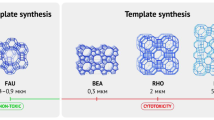Abstract
The work is devoted to studying the influence of synthesis conditions on the hydrothermal crystallization of zeolite nanoparticles with a Beta structure and studying their properties. The experimentally optimal conditions for the preparation of Beta zeolite nanoparticles of various sizes are determined by varying the temperature and time parameters of the process. The synthesized samples are characterized by X-ray diffraction analysis, scanning electron microscopy, and low-temperature nitrogen adsorption. The sorption ability of zeolite samples of different sizes with respect to inorganic cations (for example, lead ions) and organic molecules (for example, thiamine hydrochloride), as well as their hemolytic activity in relation to human red blood cells, is studied. It is found that the sorption ability of the samples decreases with increasing particle size. For the first time, the results of the dependence of the hemolytic activity of nanoparticles on their size are obtained. Based on the results obtained, conclusions are drawn about the possibility of using nanozeolites in medicine.




Similar content being viewed by others
REFERENCES
Tyapkina, E.V., Pharmacology of drugs based on natural aluminosilicates and their use in veterinary medicine, Extended Abstract of Cand. Sci. Dissertation, Krasnodar: Krasnodar Res. Vet. Inst., 2018.
Panichev, A.M., Kulakov, Yu.V., and Gul’kov, A.N., The use of zeolites in medicine, Tikhookean. Med. Zh., 2003, vol. 14, no. 4, pp. 21–24.
Kubasov, A.A., Zeolites in catalysis: Today and tomorrow, Soros. Obraz. Zh., 2000, vol. 6, pp. 44–51.
Wong, L.W., Sun, W.Q., and Chan, N.W., Zeolite microneedles for transdermal drug delivery, Stud. Surf. Sci. Catal., 2007, pp. 525–530.
Rimoli, M.G., Rabaioli, M.R., Melisi, D., Curcio, A., Mondello, S., Mirabelli, R., and Abignente, E., Synthetic zeolites as a new tool for drug delivery, J. Biomed. Mater. Res., Part A, 2007, vol. 87, no. 1, pp. 156–164.
Popov, Yu.V., Mokhov, V.M., Nebykov, D.M., and Budko, I.I., Nanodispersed particles in catalysis: Preparation and using in hydrogenation and reduction reactions (a review), Izv. Volgograd. Gos. Tekh. Univ., 2014, vol. 12, no. 7, pp. 5–44.
Mohammad Mahmoodi, N. and Saffar-Dastgerdi, M.H., Zeolite nanoparticle as a superior adsorbent with high capacity: Synthesis, surface modification and pollutant adsorption ability from wastewater, Microchem. J., 2019, vol. 145, pp. 74–83.
Mintova, S. and Valtchev, J.-P., Advances in nanosized zeolites, Nanoscale, 2013, vol. 5, pp. 6693–6703.
Bok, T., Onuchin, E., Zabil’skaya, A., Konnov, S., Knyazeva, E., Panov, A., Kleimenov, A., and Ivanova, I., Nanocrystalline zeolites beta: Features of synthesis and properties, Pet. Chem., 2016, vol. 56, pp. 1160–1167.
Knyazeva, E.E. and Ivanova, I.I., Synthesis of nanoscale zeolites, Pet. Chem., 2019, vol. 59, p. 262.
Mintova, S., Jaber, M., and Valtchev, V., Nanosized microporous crystals: Emerging applications, Chem. Soc. Rev., 2015, vol. 44, no. 20, pp. 7207–7233.
Vuong, G.-Th., Hoang, V.-Th., Nguyen, D.-T., and Do, T.-O., Synthesis of nanozeolites and nanozeolite-based FCC catalysts, and their catalytic activity in gas oil cracking reaction, Appl. Catal., A, 2010, no. 2, pp. 231–239.
Reinoso, D., Adrover, M., and Pedernera, M., Green synthesis of nanocrystalline faujasite zeolite, Ultrason. Sonochem., 2018, vol. 42, pp. 303–309.
Cheng, X., Mao, J., Xinchun, Lv., Tao Hua, et al., Fast synthesis of nanosized zeolite beta from a low-seeded, low-templated dry gel with a seeding-steam-assisted conversion method, J. Mater. Chem. A, 2014, no. 2, pp. 1247–1251.
Shimojima, A. and Kuroda, K., Designed synthesis of nanostructured siloxane-organic hybrids from amphiphilic silicon-based precursors, Chem. Record, 2006, vol. 6, no. 2, pp. 53–63.
Lehman, S.E. and Larsen, S.C., Zeolite and mesoporous silica nanomaterials: Greener syntheses, environmental applications and biological toxicity, Environ. Sci.: Nano, 2014, vol. 3, no. 1.
Golubeva, O.Yu. and Ul’yanova, N.Yu., Stabilization of silver nanoparticles and clusters in porous zeolite matrices with Rho, Beta, and paulingite structures, Glass Phys. Chem., 2015, vol. 41, no. 5, pp. 537–544.
Kulikov, K.G. and Koshlan, T.V., Measurement of sizes of colloid particles using dynamic light scattering, Tech. Phys., 2015, vol. 60, no. 12, pp. 1758–1764.
Shamova, O.V., Orlov, D.S., and Kokryakov, V.N., Antimicrobial peptides from leukocytes of Russian sturgeon (Acipenser gueldenstaedtii), Fundam. Issled., 2006, no. 1, pp. 10–13.
Bock, T.K., A novel assay to determine the hemolytic activity of drugs incorporated in colloidal carrier systems, Pharm. Res., 1994, vol. 11, no. 4, pp. 589–591.
Golubeva, O.Yu., Ul’yanova, N.Yu., Maslennikova, T.P., and Dyakina, M.P., Sorption of lead(II) ions and water vapors by synthetic hydro- and aluminosilicates with layered, framework, and nanotube morphology, Glass Phys. Chem., 2014, vol. 40, no. 2, pp. 250–255.
Shilina, A.S., Sorbpion clearing of natural and industrial waters from cations of heavy metals and radionuclides with new type of high-temperature alumosilicate adsorbent, Sorbtsionnye Khromatogr. Protsessy, 2010, vol. 10, no. 2, pp. 237–245.
Author information
Authors and Affiliations
Corresponding author
Rights and permissions
About this article
Cite this article
Ulyanova, N.Y., Kurylenko, L.N., Shamova, O.V. et al. Hemolitic Activity and Sorption Ability of Beta Zeolite Nanoparticles. Glass Phys Chem 46, 155–161 (2020). https://doi.org/10.1134/S108765962002011X
Received:
Revised:
Accepted:
Published:
Issue Date:
DOI: https://doi.org/10.1134/S108765962002011X




